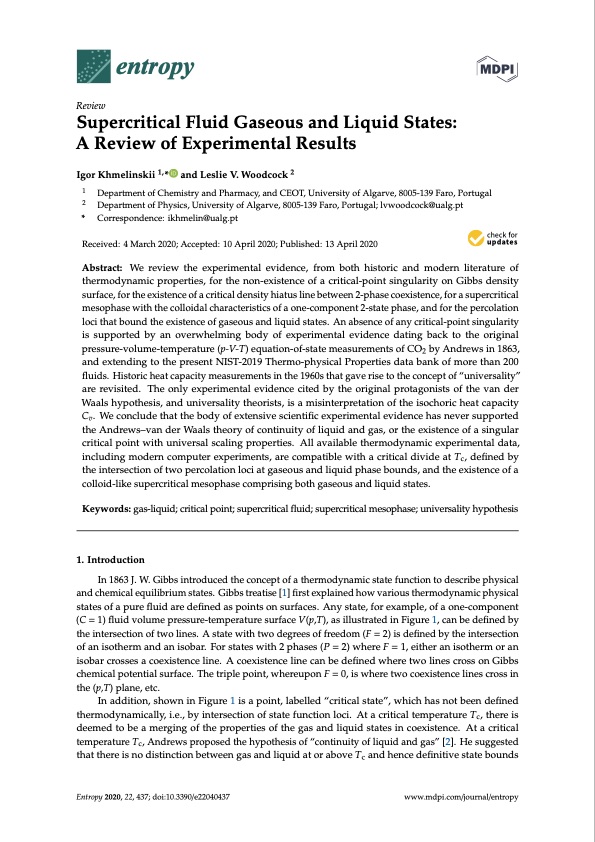
PDF Publication Title:
Text from PDF Page: 001
entropy Review Supercritical Fluid Gaseous and Liquid States: A Review of Experimental Results Igor Khmelinskii 1,* and Leslie V. Woodcock 2 1 2 Received: 4 March 2020; Accepted: 10 April 2020; Published: 13 April 2020 Department of Chemistry and Pharmacy, and CEOT, University of Algarve, 8005-139 Faro, Portugal Department of Physics, University of Algarve, 8005-139 Faro, Portugal; lvwoodcock@ualg.pt * Correspondence: ikhmelin@ualg.pt Abstract: We review the experimental evidence, from both historic and modern literature of thermodynamic properties, for the non-existence of a critical-point singularity on Gibbs density surface, for the existence of a critical density hiatus line between 2-phase coexistence, for a supercritical mesophase with the colloidal characteristics of a one-component 2-state phase, and for the percolation loci that bound the existence of gaseous and liquid states. An absence of any critical-point singularity is supported by an overwhelming body of experimental evidence dating back to the original pressure-volume-temperature (p-V-T) equation-of-state measurements of CO2 by Andrews in 1863, and extending to the present NIST-2019 Thermo-physical Properties data bank of more than 200 fluids. Historic heat capacity measurements in the 1960s that gave rise to the concept of “universality” are revisited. The only experimental evidence cited by the original protagonists of the van der Waals hypothesis, and universality theorists, is a misinterpretation of the isochoric heat capacity Cv. We conclude that the body of extensive scientific experimental evidence has never supported the Andrews–van der Waals theory of continuity of liquid and gas, or the existence of a singular critical point with universal scaling properties. All available thermodynamic experimental data, including modern computer experiments, are compatible with a critical divide at Tc, defined by the intersection of two percolation loci at gaseous and liquid phase bounds, and the existence of a colloid-like supercritical mesophase comprising both gaseous and liquid states. Keywords: gas-liquid; critical point; supercritical fluid; supercritical mesophase; universality hypothesis 1. Introduction In 1863 J. W. Gibbs introduced the concept of a thermodynamic state function to describe physical and chemical equilibrium states. Gibbs treatise [1] first explained how various thermodynamic physical states of a pure fluid are defined as points on surfaces. Any state, for example, of a one-component (C = 1) fluid volume pressure-temperature surface V(p,T), as illustrated in Figure 1, can be defined by the intersection of two lines. A state with two degrees of freedom (F = 2) is defined by the intersection of an isotherm and an isobar. For states with 2 phases (P = 2) where F = 1, either an isotherm or an isobar crosses a coexistence line. A coexistence line can be defined where two lines cross on Gibbs chemical potential surface. The triple point, whereupon F = 0, is where two coexistence lines cross in the (p,T) plane, etc. In addition, shown in Figure 1 is a point, labelled “critical state”, which has not been defined thermodynamically, i.e., by intersection of state function loci. At a critical temperature Tc, there is deemed to be a merging of the properties of the gas and liquid states in coexistence. At a critical temperature Tc, Andrews proposed the hypothesis of “continuity of liquid and gas” [2]. He suggested that there is no distinction between gas and liquid at or above Tc and hence definitive state bounds Entropy 2020, 22, 437; doi:10.3390/e22040437 www.mdpi.com/journal/entropyPDF Image | Supercritical Fluid Gaseous and Liquid States

PDF Search Title:
Supercritical Fluid Gaseous and Liquid StatesOriginal File Name Searched:
entropy-22-00437.pdfDIY PDF Search: Google It | Yahoo | Bing
Sulfur Deposition on Carbon Nanofibers using Supercritical CO2 Sulfur Deposition on Carbon Nanofibers using Supercritical CO2. Gamma sulfur also known as mother of pearl sulfur and nacreous sulfur... More Info
CO2 Organic Rankine Cycle Experimenter Platform The supercritical CO2 phase change system is both a heat pump and organic rankine cycle which can be used for those purposes and as a supercritical extractor for advanced subcritical and supercritical extraction technology. Uses include producing nanoparticles, precious metal CO2 extraction, lithium battery recycling, and other applications... More Info
| CONTACT TEL: 608-238-6001 Email: greg@infinityturbine.com | RSS | AMP |